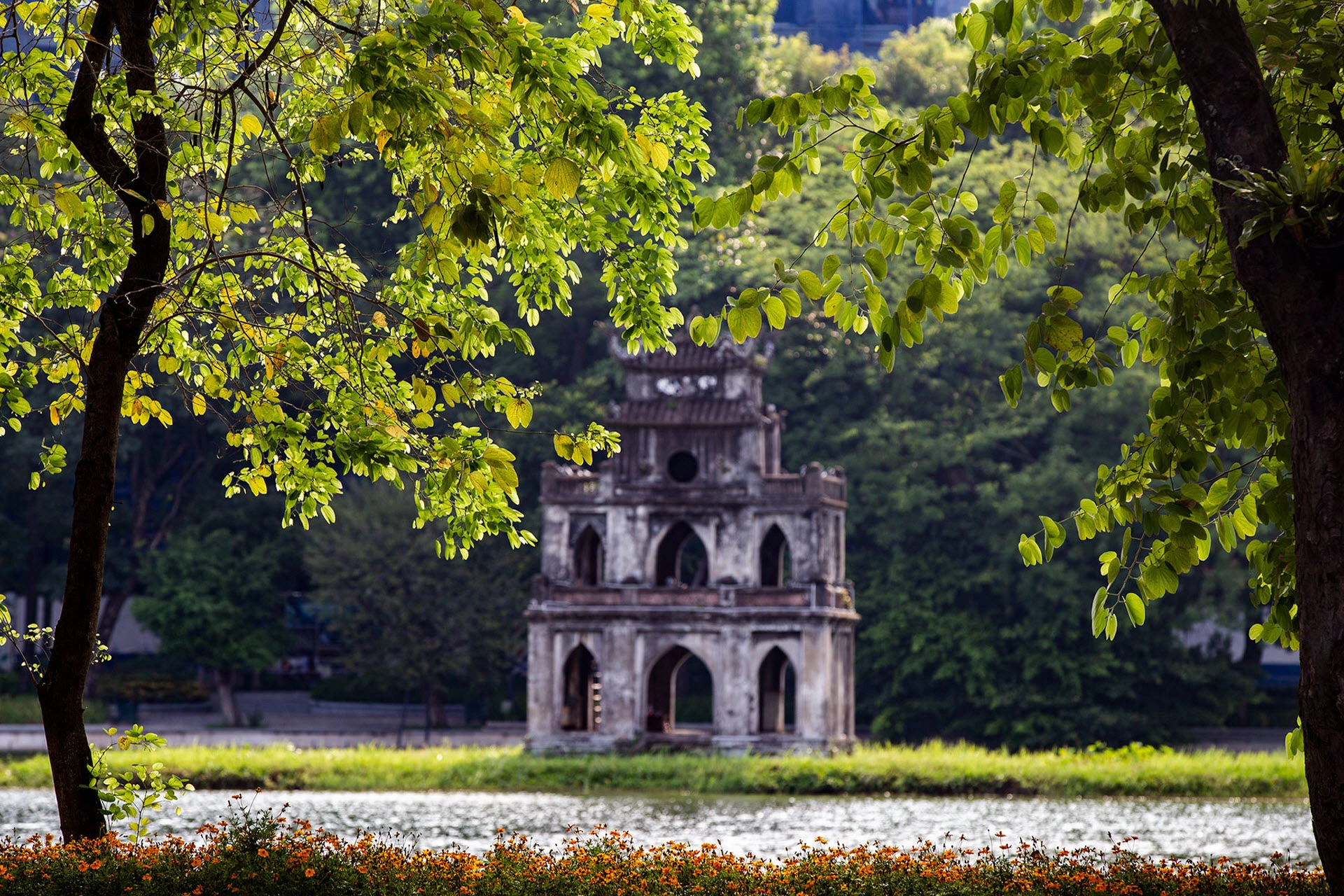
A potent combination of the ancient, the modern and the in-between, Hanoi boasts historic vestiges, colonial heritages and guild streets with food and beer joints to write home about.
The autumn season from September to November and spring between March and April are the most ideal times to visit Hanoi when the weather is pleasant with milder temperatures.
In winter, Hanoi can get quite cold, with the temperatures falling below 10 degrees Celsius.
Among the fascinating aspects of Hanoi are vestiges of Vietnam’s feudal dynasties like the Thang Long Imperial Citadel, recognized as a UNESCO world heritage site. Today, royal court ceremonies and ancient dance performances are presented at night.
Constructed in the 11th century during the Ly Dynasty era, the citadel marks the independence of Dai Viet, today’s Vietnam. It used to be the seat of power for almost 13 centuries, through the Ly, Tran and Le dynasties.
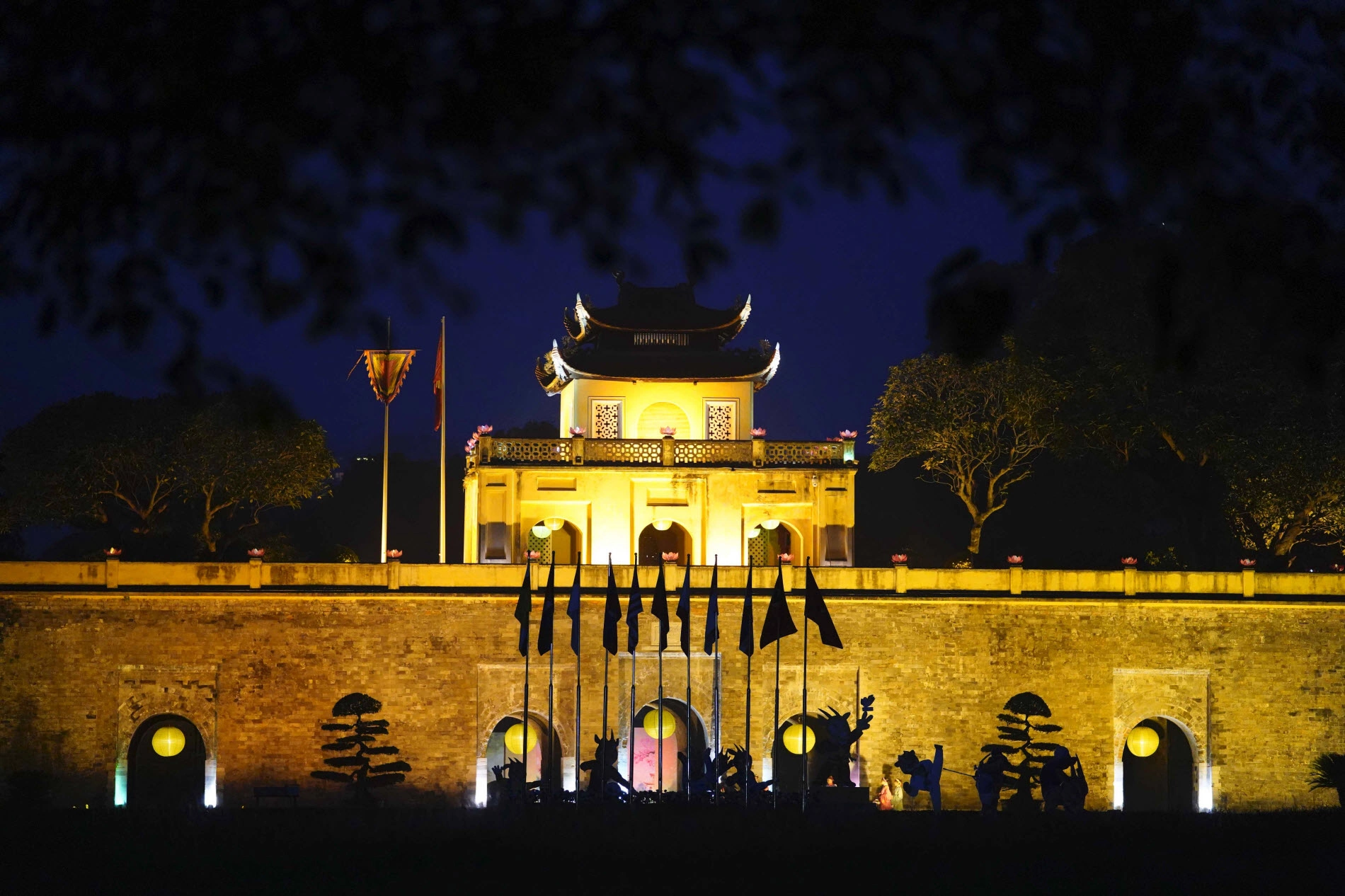
A 90-minute night tour on weekends starts from Doan Mon, the main gate of the imperial citadel at 18 Hoang Dieu Street in Ba Dinh District. Tourists can watch royal ceremonies and dance performances staged amidst the archaeological remains, admire artifacts associated with Vietnam’s feudal dynasties and offer incense tributes to 52 former kings at the Kinh Thien Palace. This tour costs VND300,000 ($12.95) per person.
Moving from feudal to contemporary history, the next destination most foreign tourists want to visit when they are in Hanoi is the Hoa Lo Prison museum due to its direct link with the Vietnam War. Former U.S. Senator John McCain was one of its prisoners.

In 1990, the prison was mostly torn down to build a couple of skyscrapers. The remaining part of the facility and the main gate were turned into "a living museum" that holds evidence of war crimes and highlights the resilience and fighting spirit of Vietnamese soldiers.
The museum is open from 8 a.m. to 5 p.m. every day. Now, one can also visit the museum at night with a special tour that costs VND100,000 ($4.30) per person.
"Even though many parts are disturbing, the Hoa Lo Prison is historically important and recommended as a must-visit stop on any Hanoi itinerary. The displays are well done with good English descriptions on labelling. There is a small section regarding the time frame when it housed American POWs, like John McCain. There are both interior and exterior displays," a Tripadvisor reader writes.
A cycling tour of Thang Long Tu Tran, which consists of four sacred temples worshipping the deities who guard the four main posts of the citadel to protect it from devils, is also a must-try experience.

The six-hour tour departs from Long Bien Bridge and stops at four temples: Bach Ma in the east of Hanoi, Voi Phuc in the West, Kim Lien in the south and Quan Thanh in the north.
Costing VND1.2 million ($51.65) per person, the tour also includes water puppet shows depicting age-old fables and mythical lore, like the famous Hanoi parable about a Vietnamese king's treasured sword that was used to fight off Chinese invaders.
Considered the biggest freshwater lake in Hanoi, the West Lake area in Tay Ho District is famous for the density of its historical relics, pagodas and rows of restaurants and coffee shops that make it ideal to hang out at any time the day or week.

Thanh Nien Street, between West Lake and Truc Bach Lake, is brightly lit at dusk. Photo by Nghiem Dinh Chinh
The area is one of the city’s most vibrant culinary centers for international cuisine and is home to a large expat community who love riding their bicycles along green trees and lotus ponds around the lake.
There are several places to rent bicycles around the West Lake. Bike stores at 29 Nhat Chieu Street, 96 Yen Hoa, Yen Phu Street, or 81 Lac Long Quan Street are good places to rent a bike. Bikes can also be rented in the Old Quarter.
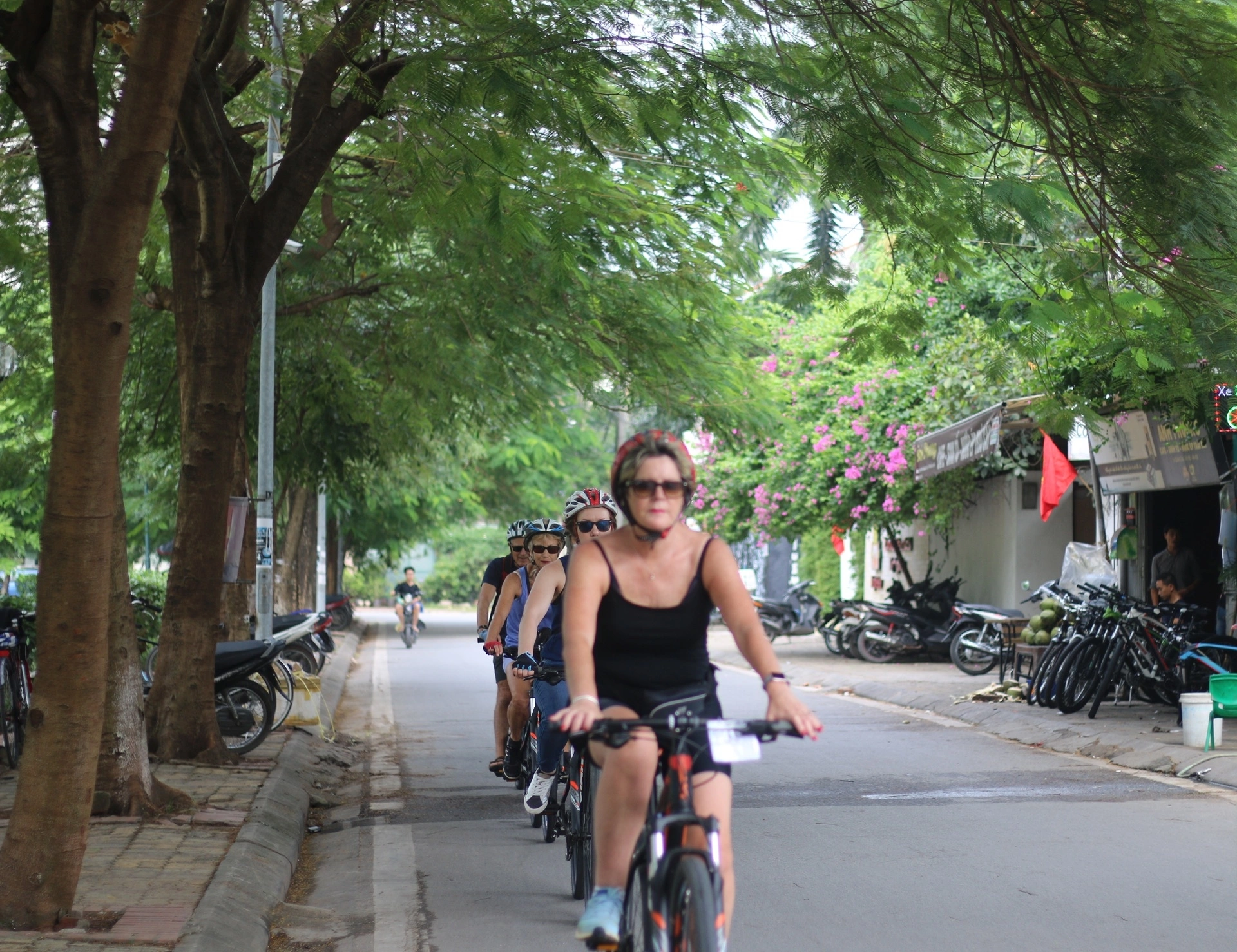
Daily rents range from VND100,000-200,000 ($4.30-8.60).
Along the way, tourists can visit Tran Quoc Pagoda, one of the most sacred places in Vietnam, hosting a cutting of the original Bodhi tree under which the Buddha sat and achieved enlightenment.

The pagoda also has several priceless statues in the front yard. Hundreds of years old, the statues were engraved and polished meticulously by skilful craftsmen.
Near Tran Quoc Pagoda is the Quan Thanh Temple, one of the four most sacred temples of Hanoi, which gets crowded on the first and 15th day of every lunar month.
NIGHTLIFE SCENE
Since March, the 200-meter-long Ta Hien beer street inside the Hanoi’s Old Quarter, a vibrant symbol of the city’s nightlife, has returned to its old self after beer shops and restaurants were allowed to remain open until midnight.
Before the pandemic, Ta Hien, which connects Luong Ngoc Quyen, Ma May and Hang Bac streets, was jam packed with locals and foreigners until 1-2 a.m.
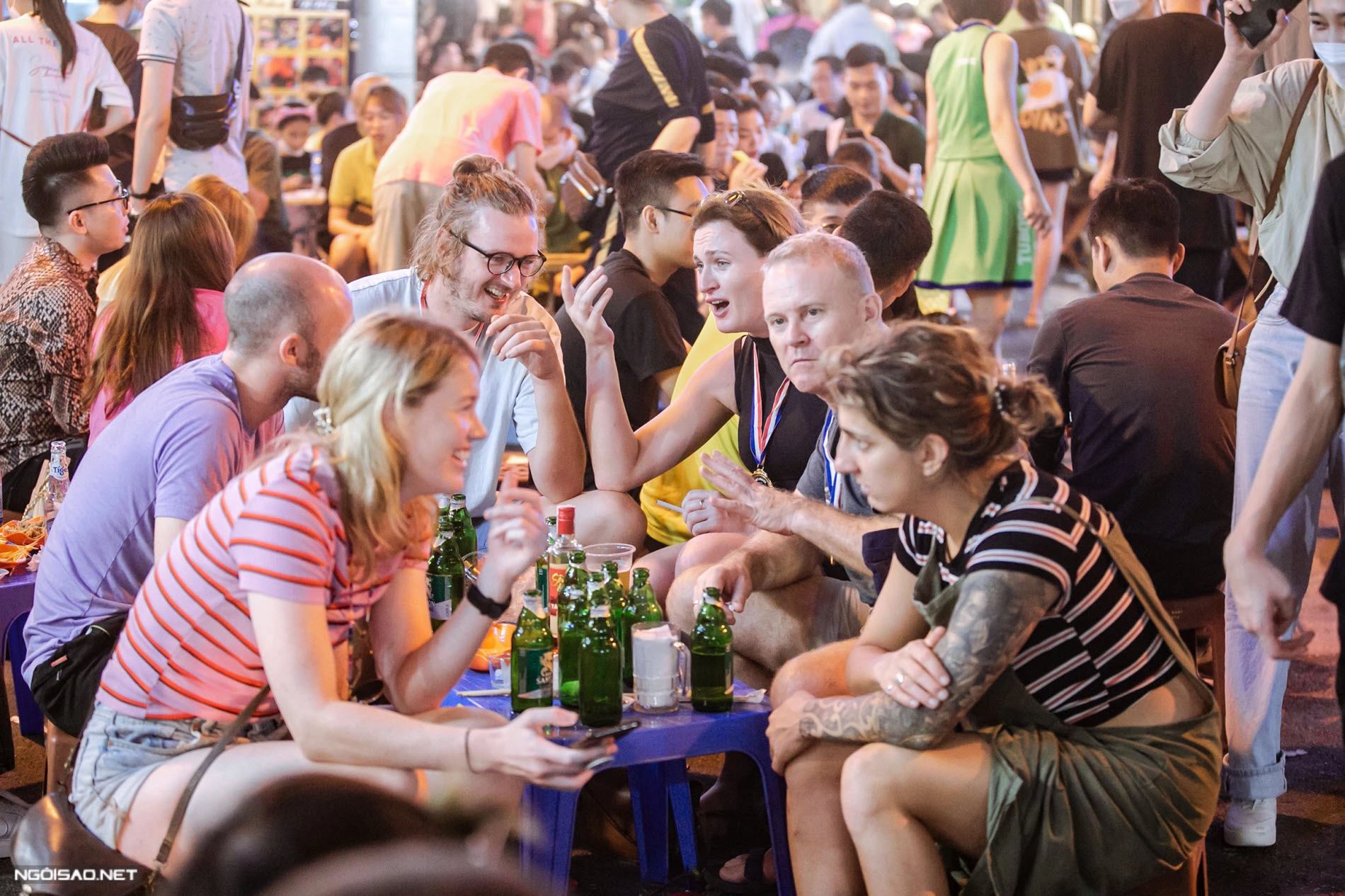
For many foreign tourists, sitting on plastic tools along the sidewalk and drinking bia hoi, locally-brewed and made fresh every day, is an experience that gives them a local feeling.
A glass of bia hoi, about 300 ml, costs between VND7,000-10,000 ($0.30-0.43); while a bottle or a can of beer can cost anywhere between VND25,000-200,000.
Most bia hoi joints also serve inexpensive street food like prawns barbecued with chili and salt, clams steamed with lemongrass, or green mango with a prawn-chili-salt dip.
Most bars and pubs in Hanoi are conveniently located in the Old Quarter.
Here are a few addresses with terrific views of the city’s iconic tourist attractions: Twilight Sky Bar and Restaurant, Lighthouse Sky Bar & Restaurant, MK Rooftop Bar & Restaurant, Mojito Bar & Lounge, Craft Beer Pub and Claw Pub Hanoi.
The Quang Ba Flower Market and Long Bien Wholesale Market are the places to visit to get a true sense of Hanoi's nightlife.
Once night falls, Quang Ba becomes radiant with fresh flowers of all hues glowing in the yellow lights of market stalls. The market stays open through the night and is at its busiest at 3-4 a.m. when retailers rushing to and from with huge bundles of fresh flowers.
The Long Bien Wholesale Market is less romantic than Quang Ba, but provides a more vivid picture of the country's traditional morning markets as thousands of vendors from Hanoi and surrounding areas gather to trade their goods.
From downtown Hanoi, visitors can take a taxi or ride-hailing service to the Thay Pagoda, 30km southwest of Hanoi and at the foot of Sai Son Mountain, to watch The Quintessence of Tonkin show.
Arranged on an interactive stage with state-of-the-art technology and a stunning setting, the show features an array of traditional art forms and ritual practices from the northern delta like ca tru (ceremonial singing), folklore melodies, quan ho (love duet singing), hau dong (spirit possession ritual), and water puppetry.
The stage is permanently under the water and large enough to accommodate 250 performers at a time.
The show mainly tells the story of Monk Tu Dao Hanh, who was well-known for his humility and compassion for the poor. Legend has it that Hanh invented water puppetry to depict the lives of rural people.
Tickets cost VND300,000 and VND400,000.
For those wanting a respite from the urban hustle and bustle, the Ba Vi National Park on the outskirts of Hanoi is an ideal place.
Just an hour and a half from downtown Hanoi, the 11,000-hectare Ba Vi National Park has a popular weekend destination that allows people to reconnect with nature and recharge their betteries.
Located in the Ba Vi mountain range, the park has a rich and diverse range of tropical and subtropical flora and fauna, making it an ideal choice for camping.

Entry tickets to the park cost VND60,000 ($2.64) for adults and VND10,000 ($0.44) for children. Visitors can bring tents, barbecues, tables, and chairs or rent them at VND60,000-450,000.
If visitors want to camp overnight in the park, they have to pay VND50,000 per adult. At night the temperature drops, and so it is advisable to carry sleeping bags, blankets and warm clothes.
If you want to stay inside the Old Quarter near Hanoi’s famous attractions, some hotel addresses to be considered are La Siesta Classic Ma May, Hanoi Bella Rosa Trendy Hotel, Lavender Central Hotel & Spa, Hanoi Allure Hotel and Maison D'Hanoi Boutique Hotel with prices ranging from VND350,000 to VND1 million a night.
Some luxury hotels with a touch of French architecture include the Sofitel Legend Metropole Hanoi, Hilton Hanoi Opera and Apricot Hotel right on the banks of Hoan Kiem Lake.
In the West Lake area, Sheraton Hanoi and InterContinental Hanoi Westlake and Lotte Hotel Hanoi are great options.
Bun cha, a bowl of savory, sweet and sour fish sauce with meatballs and thick pork slices served with a plate of white vermicelli, got a publicity boost after former President Barack Obama enjoyed this dish during his 2016 trip to Vietnam.
Bun cha is typically served with seafood spring rolls, crab spring rolls and grilled skewers.
Some famous addresses to try the dish are 74 Hang Quat Street and Huong Lien Stall on Le Van Huu Street that Obama and the late chef Anthony Bourdain visited in 2016.
Cha ca (fried catfish) is one of the unique specialties of Hanoians and it even has a street named after it.
This dish is said to be more than 130 years old. It was first created by the Doan family to serve Vietnamese fighters against the French occupants. The original Cha Ca La Vong restaurant operates till today.
Diners sit at a communal table with a skillet set up over a burner. Turmeric-marinated fish is added to sizzling garlic oil, and dill and shrimp paste tossed in. The diners’ job is to add herbs, marinated hot chilies, peanuts and vermicelli, which are all laid out on the table.

A set of La Vong fried catfish costs VND175,000 ($7.58) per person.
Xoi xeo, a sticky rice dish topped with green mung bean paste and dried shallots in its basic form is a popular breakfast dish and late night snack. One can opt for a variety of add-ons like pate, boiled chicken, cha lua (Vietnamese pork bologna), marinated pork belly, or preserved eggs.
Some restaurants also serve xoi xeo as dessert, topped with dried coconut shavings, roasted sesame seeds, and crystallized sugar.
An inexpensive yet prominent xoi xeo restaurant is Ms. Yen, where you can enjoy a basic bowl for VND15,000.
Another breakfast and late night staple of Hanoians is banh cuon (steamed rice rolls), stuffed with ground pork meat and minced mushrooms.
It is served with fried shallots and cilantro on top.
The flavor of the dish lies in the fish sauce dipping and a drop of ca cuong, a giant water bug essence that adds an extra flavor of scallop or shrimp.
The most famous address in Hanoi to try this treat is Gia Truyen stall at 12 Hang Ga Street.
Banh tom, a deep fried rice powder cake with shrimp, is another Hanoi specialty served by many restaurants across the West Lake.
The most well-known restaurant for this dish is on Thanh Nien Street between the West Lake and Truc Bach Lake. It is typically served with lettuce leaves for wrapping and chili, lime juice and fish sauce for dipping. What made the dish special in yesteryears was that it was made with freshwater shrimp caught in the West Lake.
There are daily direct flights from HCMC to Hanoi which takes around two hours with one-way ticket prices starting at VND509,000.
If one is not pressed for time, a 32-hour train journey from HCMC to Hanoi allows for a unique experience and interaction with length and breadth of the country.
Hanoi’s Noi Bai International Airport is approximately 30 kilometers from the city center and driving from the airport to the downtown area typically takes about 45 minutes.
Taxis aren't too expensive, but budget travelers are well served by public buses that leave from the airport. Bus 86 goes straight to the Old Quarter while Bus 7 goes to the Kim Ma bus station, and Bus 17 goes to the Long Bien bus station.
The newly launched double-decker bus tour for VND130,000 to VND599,000 is a good package deal to visit major attractions and get a feel for Hanoi as it winds its way through many major streets.
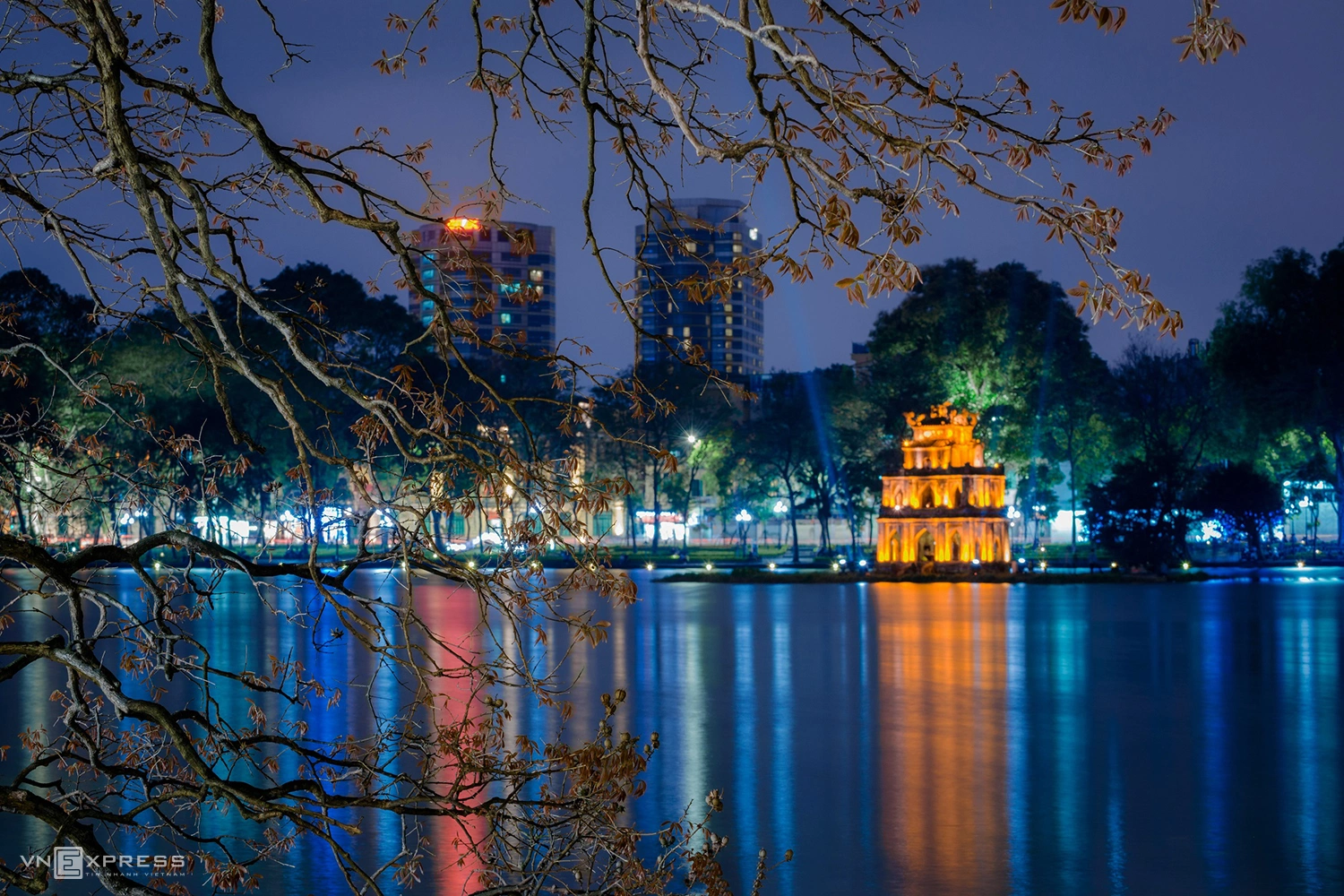
Turtle Tower, an iconic symbol of Hanoi in the middle of Hoan Kiem (Sword) Lake, shines at night. Photo by Nghiem Dinh Chinh
Story by Hoang Phong